Special Report
Cities With the Worst COVID-19 Unemployment Crisis Right Now
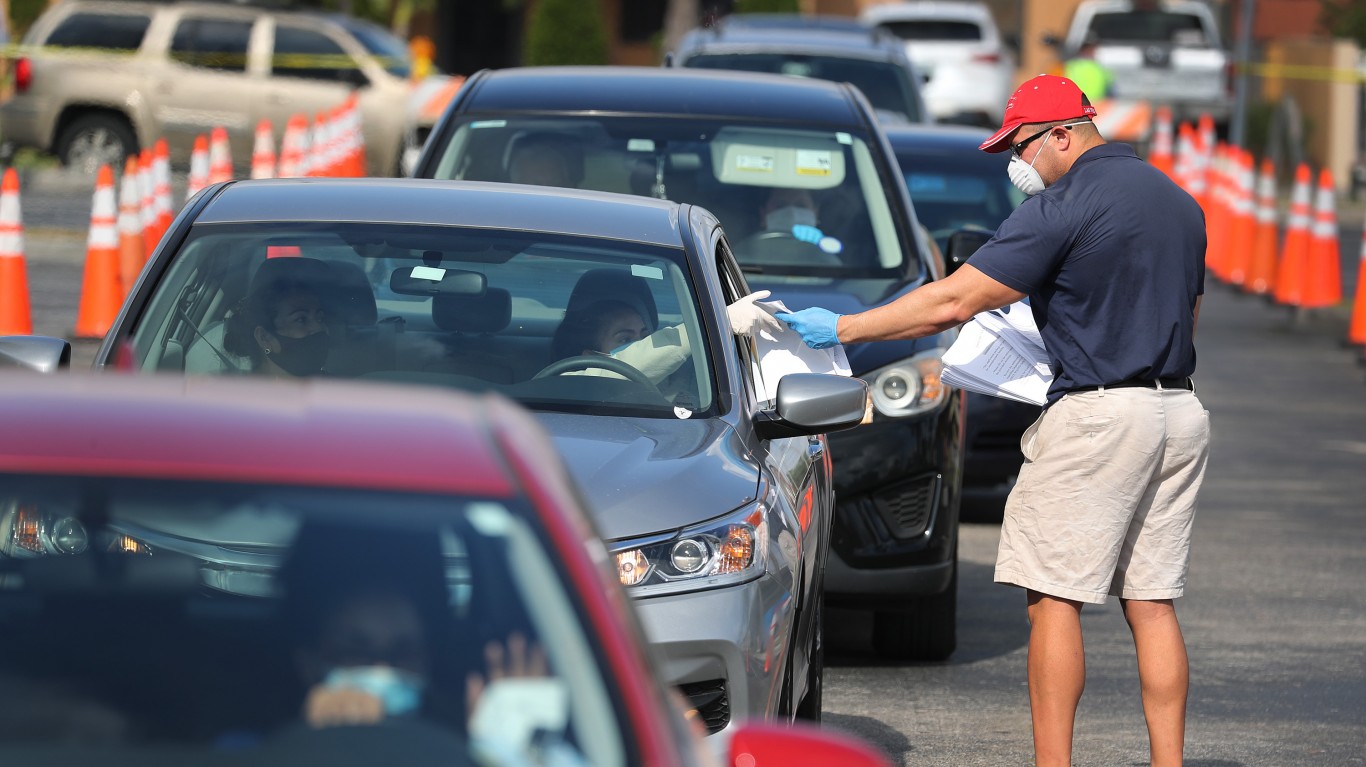
Published:

After HIV/AIDS, COVID-19 is the deadliest pandemic the world has faced in over a century. And in the United States, the virus has ushered in an economic crisis of a scale not seen since the Great Depression.
Efforts to contain the spread of the coronavirus have grounded large segments of the U.S. economy to a halt and sent the unemployment rate soaring to a post WWII high of 14.7% in April 2020. Though the U.S. unemployment rate has improved substantially in the months since, falling to 7.9% in September, in some parts of the country the recovery has been far more modest. In dozens of major metropolitan areas, the unemployment rate remains in the double digits.
Using data from the Bureau of Labor Statistics, 24/7 Wall St. identified the American cities with double-digit unemployment. The metro areas on this list are ranked by their September 2020 unemployment rate, and in the case of a tie, the metro area where overall employment fell the most in the last year is ranked higher.
In the past 12 months, no industry has shed more jobs in the United States than leisure and hospitality. As COVID-19 effectively ended nonessential travel for months, the number of Americans working in leisure and hospitality cratered by more than 21% from September 2019 to September 2020. Not surprisingly, many of the cities where unemployment remains high, such as Honolulu and Las Vegas, are cities that depend the most on tourism. Here is a full list of the industries being devastated by the coronavirus.
Many of the metro areas with double-digit unemployment are also home to large populations living below the poverty line. In these areas, the rapid evaporation of jobs has added further financial strain on households that were already struggling. Here is a look at America’s poorest cities.
Click here to see the cities with the worst COVID-19 unemployment crisis right now.
Click here to read our detailed methodology.
30. Leominster-Gardner, MA
> Sept. 2020 unemployment rate: 10.7%
> 1 yr. employment change: -9.2%
> Largest industry: Education and health services (20.8% of local jobs)
> Population: N/A
The unemployment rate in Leominster-Gardner, a metro area in north-central Massachusetts, stands at 10.7% — well above the comparable 7.9% national rate. The local job market went from being one of the best in the country in March 2020, with a 3.1% jobless rate, to one of the worst in April, when unemployment hit 17.4%. Since peaking at 19.2% in June, unemployment has steadily improved in Leominster-Gardner.
Nationwide, the industry hit hardest by the COVID-19 recession was leisure and hospitality. In Leominster-Gardner, however, information was the hardest-hit industry, shedding 25.0% of jobs over the past year. The local leisure and hospitality industry workforce contracted by 22.0% over the same period.
[in-text-ad]
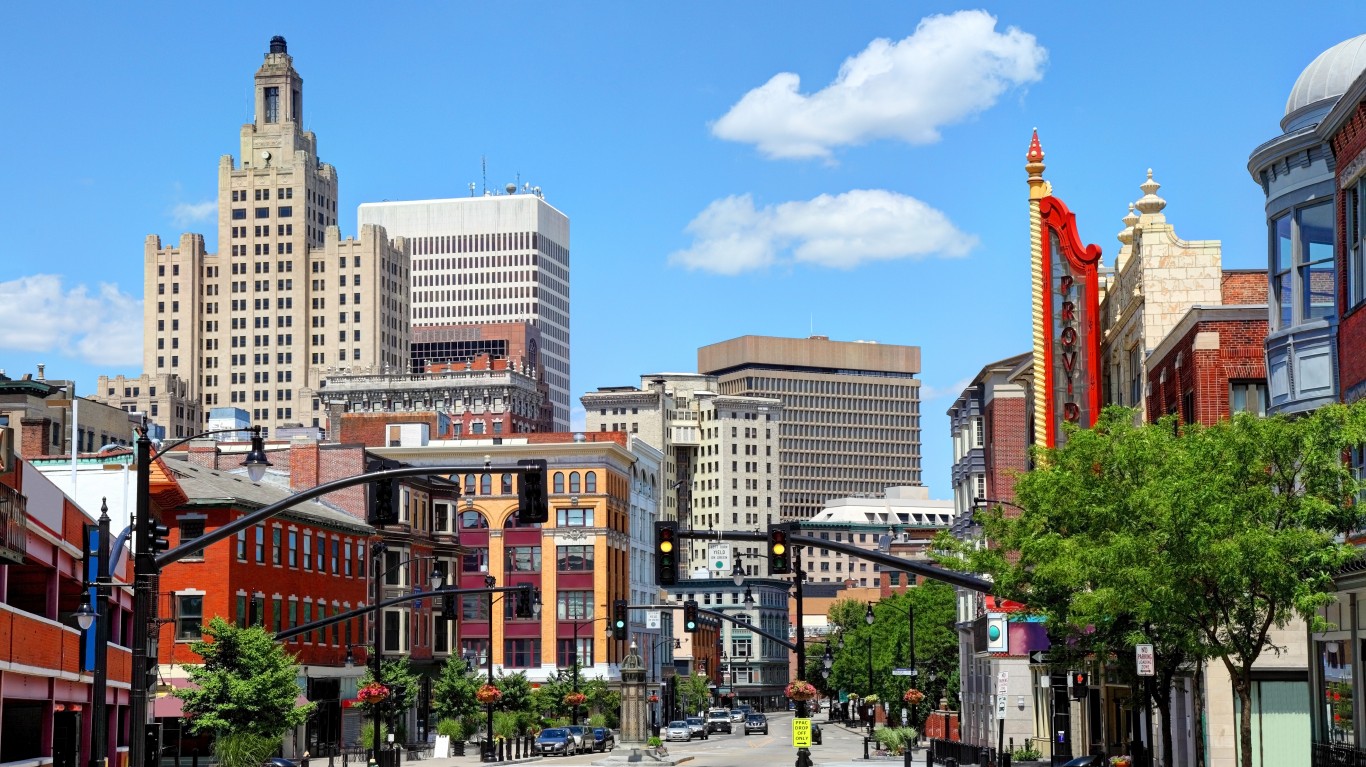
29. Providence-Warwick, RI-MA
> Sept. 2020 unemployment rate: 10.8%
> 1 yr. employment change: -6.6%
> Largest industry: Education and health services (21.3% of local jobs)
> Population: 1.6 million
The Providence-Warwick metro area has the second highest unemployment rate in New England and the 29th highest nationwide. Due in large part to the COVID-19 recession, there are about 40,000 fewer people working in Providence than there were one year ago. As is the case across the country, the area’s leisure and hospitality industry and services sectors were the hardest hit by the pandemic. Providence’s unemployment rate hit a one-year high of 18.5% in April 2020 and now stands at 10.8%.

28. Chicago-Naperville-Elgin, IL-IN-WI
> Sept. 2020 unemployment rate: 10.9%
> 1 yr. employment change: -7.2%
> Largest industry: Trade, transportation, and utilities (19.7% of local jobs)
> Population: 9.5 million
Chicago’s is one of three metropolitan areas in the Midwest with double-digit unemployment. The job market in the Chicago area was decimated by the COVID-19 pandemic as unemployment shot from 4.6% in March to 17.6% in April. As of September, the jobless rate in the area was 10.9%, as there are about 345,900 fewer jobs than there were in September 2019.
Over that period, every industry in Chicago shed jobs, but none contracted as much as the leisure and hospitality industry, where the number of workers fell by 23.5%.

27. Atlantic City-Hammonton, NJ
> Sept. 2020 unemployment rate: 10.9%
> 1 yr. employment change: -14.1%
> Largest industry: Leisure and hospitality (31.4% of local jobs)
> Population: 263,670
Tourism is the backbone of Atlantic City’s economy, and when the COVID-19 pandemic ground nonessential travel to a halt in much of the country, the Atlantic City metro area felt the squeeze as much as anywhere else, if not more. From March to April, unemployment in the metro area jumped from 5.3% to 34.0%. When Atlantic City’s monthly jobless rate peaked at 35.2% in June, it was the highest of any metro area in the country. Unemployment has improved considerably in the months since, however, and now stands at 10.9%,
[in-text-ad-2]

26. Muskegon, MI
> Sept. 2020 unemployment rate: 11.0%
> 1 yr. employment change: -11.0%
> Largest industry: Manufacturing (21.3% of local jobs)
> Population: 173,566
The unemployment rate in the Muskegon, Michigan, metropolitan area more than doubled — from 4.2% in September 2019 to 11.0% a year later.
Nationwide, the industry hit hardest by the COVID-19 recession was leisure and hospitality. In Muskegon, however, information was the hardest hit industry, shedding 33.3% of jobs over the past year. The local leisure and hospitality industry workforce in Muskegon contracted by 31.6% over the same period.
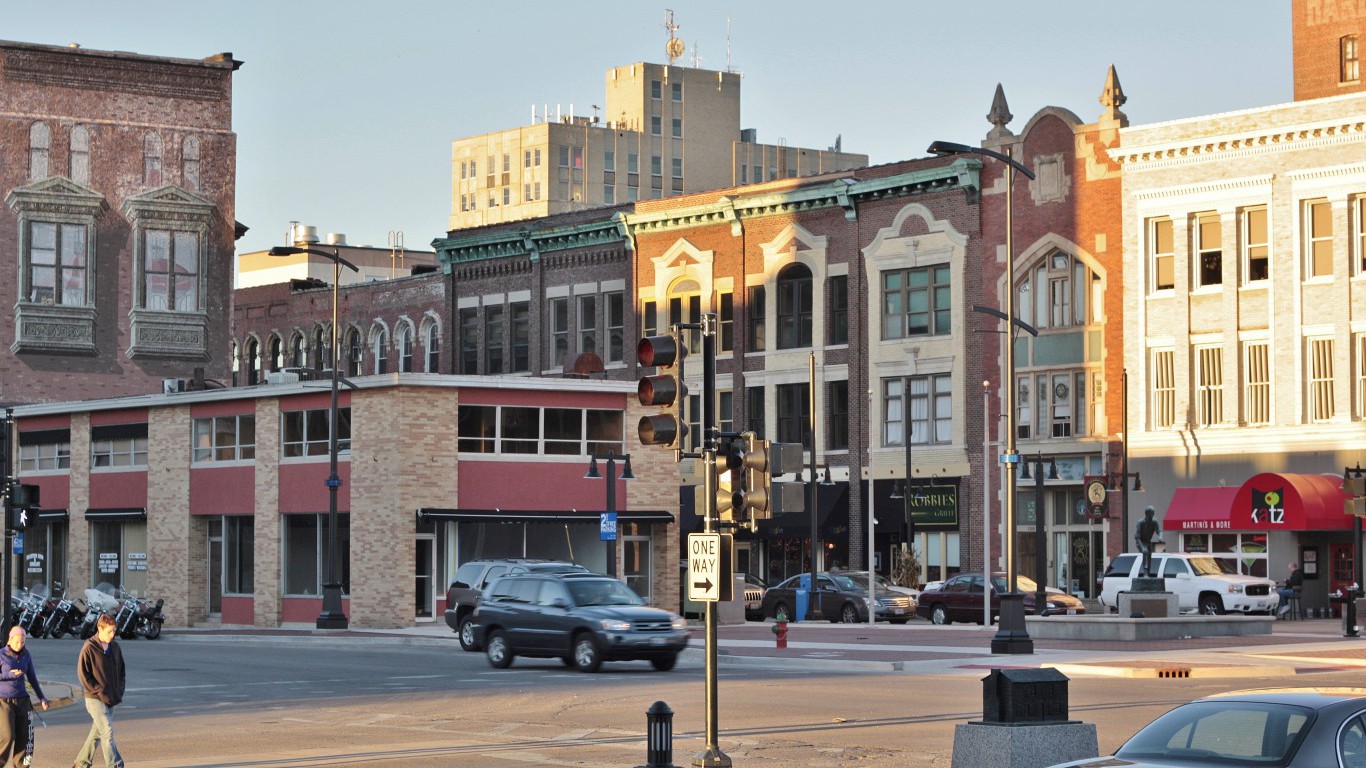
25. Decatur, IL
> Sept. 2020 unemployment rate: 11.1%
> 1 yr. employment change: -7.5%
> Largest industry: Manufacturing (21.6% of local jobs)
> Population: 104,009
The COVID-19 pandemic took a considerable toll on the economy in Decatur, Illinois. The local unemployment rate more than tripled from 4.7% in March 2020 to 17.0% the following month. Though the local jobless rate has improved considerably since then, declining to 11.1% in September, it remains among the highest of any U.S. metro area. Employment in the area’s leisure and hospitality and information industries has fallen by a third and a quarter, respectively, compared to the same time last year.
[in-text-ad]

24. Ocean City, NJ
> Sept. 2020 unemployment rate: 11.1%
> 1 yr. employment change: -16.8%
> Largest industry: Leisure and hospitality (33.4% of local jobs)
> Population: 92,039
In Ocean City, located in southern New Jersey along the Atlantic coast, tourism is an economic pillar. Over one third of the local workforce is employed in the leisure and hospitality industry, which is also the industry that has been hit hardest by the COVID-19 pandemic. From September 2019 to September 2020, the number of leisure and hospitality jobs in Ocean City fell by 28.6%, contributing to the spike in the city’s unemployment rate from 7.3% to 11.1% over the same period.
Though Ocean City’s jobless rate is higher than that of most U.S. metro areas, it has improved considerably in recent months. In June 2020, over a quarter of the local labor force was unemployed.
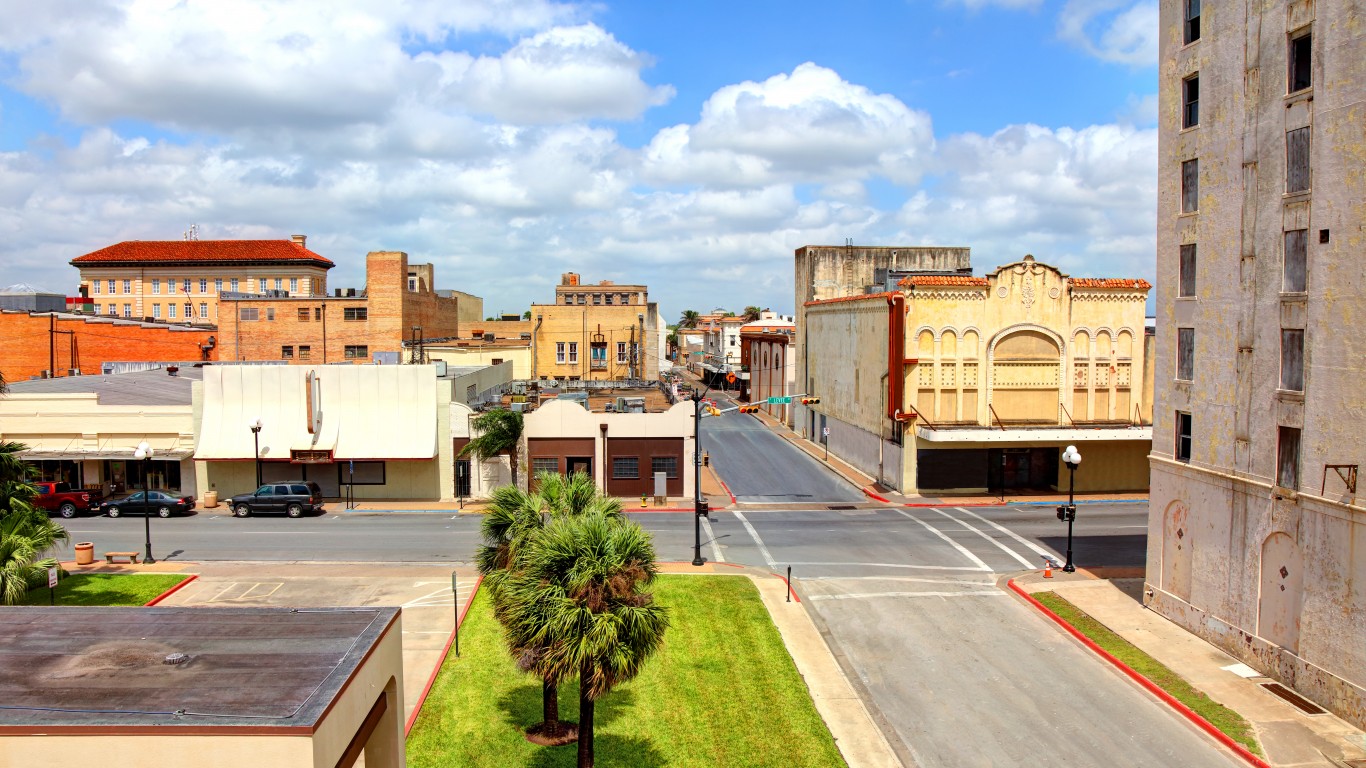
23. Brownsville-Harlingen, TX
> Sept. 2020 unemployment rate: 11.2%
> 1 yr. employment change: -6.1%
> Largest industry: Education and health services (29.3% of local jobs)
> Population: 423,163
The Brownsville-Harlingen metro area, the southernmost in Texas, has a near nation-leading 11.2% unemployment rate. Over the past year, due in large part to the economic fallout from the COVID-19 pandemic, the area shed nearly 9,000 jobs, and the September 2019 unemployment rate of 5.5% more than doubled.
The industries hit hardest in the area were leisure and hospitality, which reported an 18.1% employment decline, and information, which shed about 14.3% of its workers.
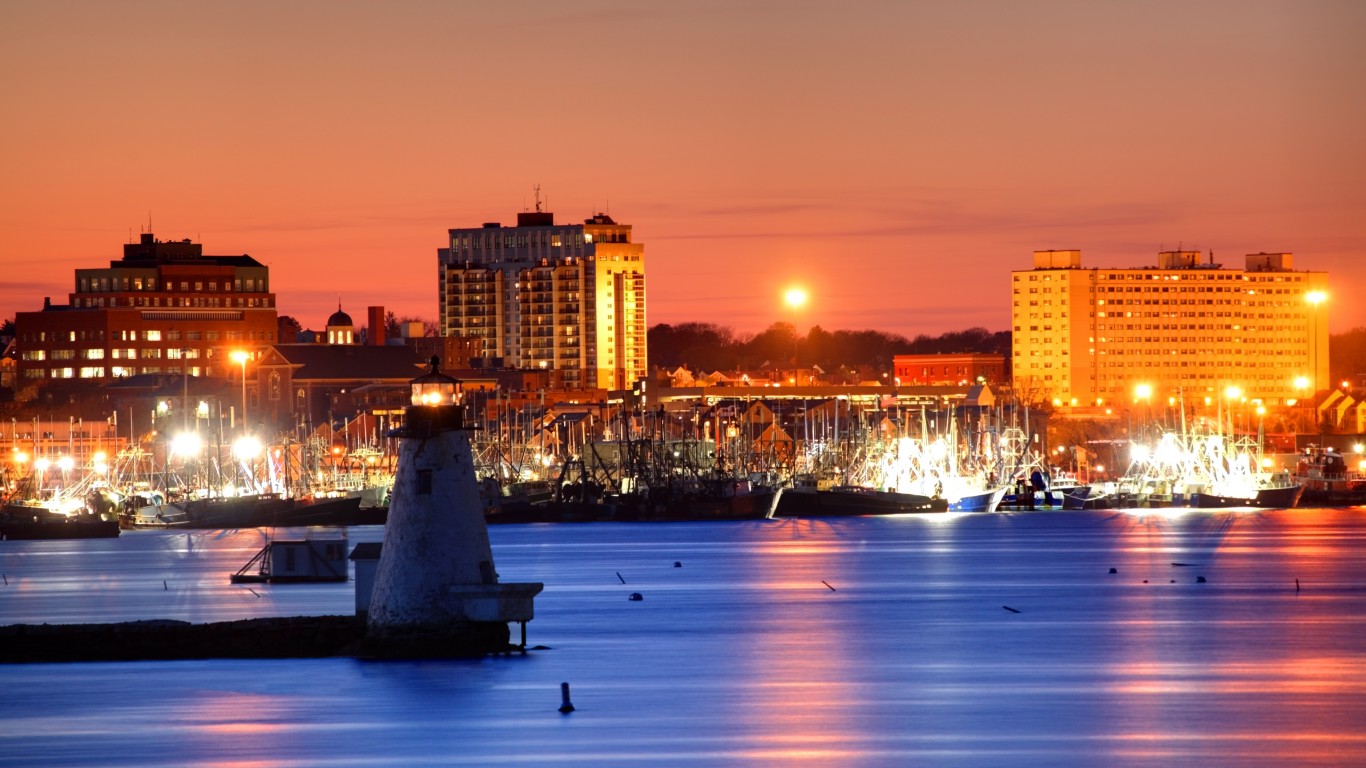
22. New Bedford, MA
> Sept. 2020 unemployment rate: 11.2%
> 1 yr. employment change: -7.7%
> Largest industry: Education and health services (25.9% of local jobs)
> Population: N/A
The 11.2% unemployment rate in New Bedford is the highest in Massachusetts and the entire Northeast region. Only a year ago, the local jobless rate was just 4.4%. After the COVID-19 pandemic reached American shores, however, unemployment spiked in New Bedford, reaching a peak of 22.3% in April.
The local industries that contracted the most in the past year were leisure and hospitality, which shed 23.6% of its workforce, followed by miscellaneous services, which reported a 20.0% decline in employment. However, education and health care, the largest industry in the area, reported just 2.9% decline in employment.
[in-text-ad-2]

21. Madera, CA
> Sept. 2020 unemployment rate: 11.3%
> 1 yr. employment change: -4.0%
> Largest industry: Government (28.1% of local jobs)
> Population: 157,327
The unemployment rate in Madera, California, stands at 11.3% — well above the 6.7% rate at the beginning of the year, but a considerable improvement from the 16.0% peak in April and May.
Like many of the California metro areas on this list, Madera is still struggling to contain the spread of the coronavirus, and businesses are suffering as a result. The broader Madera County is under the tightest restrictions laid out by California Gov. Gavin Newsom. The restrictions dictate that most nonessential and indoor businesses are to remain closed.

20. Farmington, NM
> Sept. 2020 unemployment rate: 11.4%
> 1 yr. employment change: -7.8%
> Largest industry: N/A
> Population: 123,958
Farmington is the only metro area in New Mexico in which at least 10% of the labor force is unemployed. At the beginning of the year, the metro area’s unemployment rate was less than 6%. By April, after the coronavirus had shut down large segments of the national economy, unemployment in Farmington spiked to 13.6% and peaked at 14.5% in July. Since then, however, the local jobless rate has improved every month and now stands at 11.4%.
[in-text-ad]
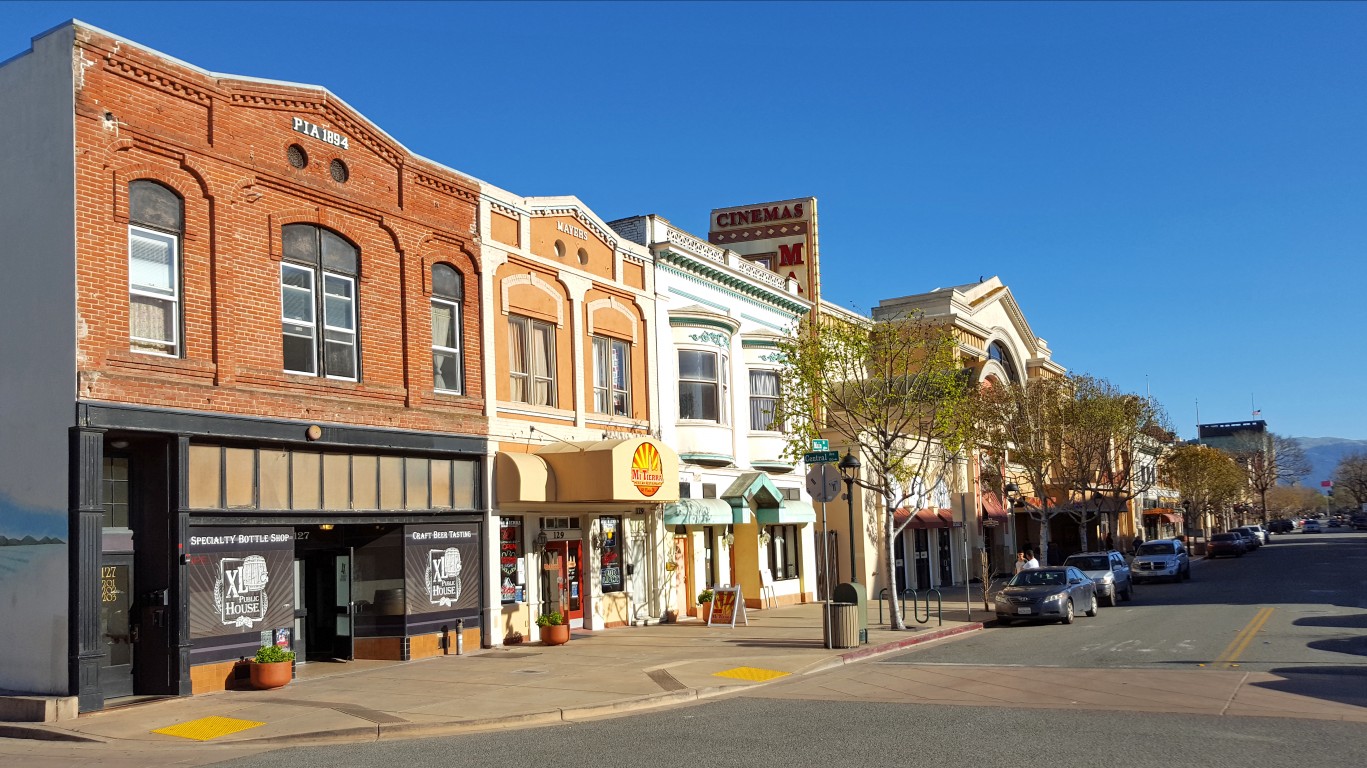
19. Salinas, CA
> Sept. 2020 unemployment rate: 11.6%
> 1 yr. employment change: -11.0%
> Largest industry: Government (23.5% of local jobs)
> Population: 434,061
Over the past year, Salinas, California, shed about 16,000 jobs. The losses, largely resulting from the COVID-19 pandemic, were concentrated in the metro area’s leisure and hospitality industry, which reported a 22.6% employment decline, as well as the professional and business services industry, where employment fell by 17.8%. As of September 2020, Salinas’ unemployment rate was 11.6%, up from 5.9% one year earlier.
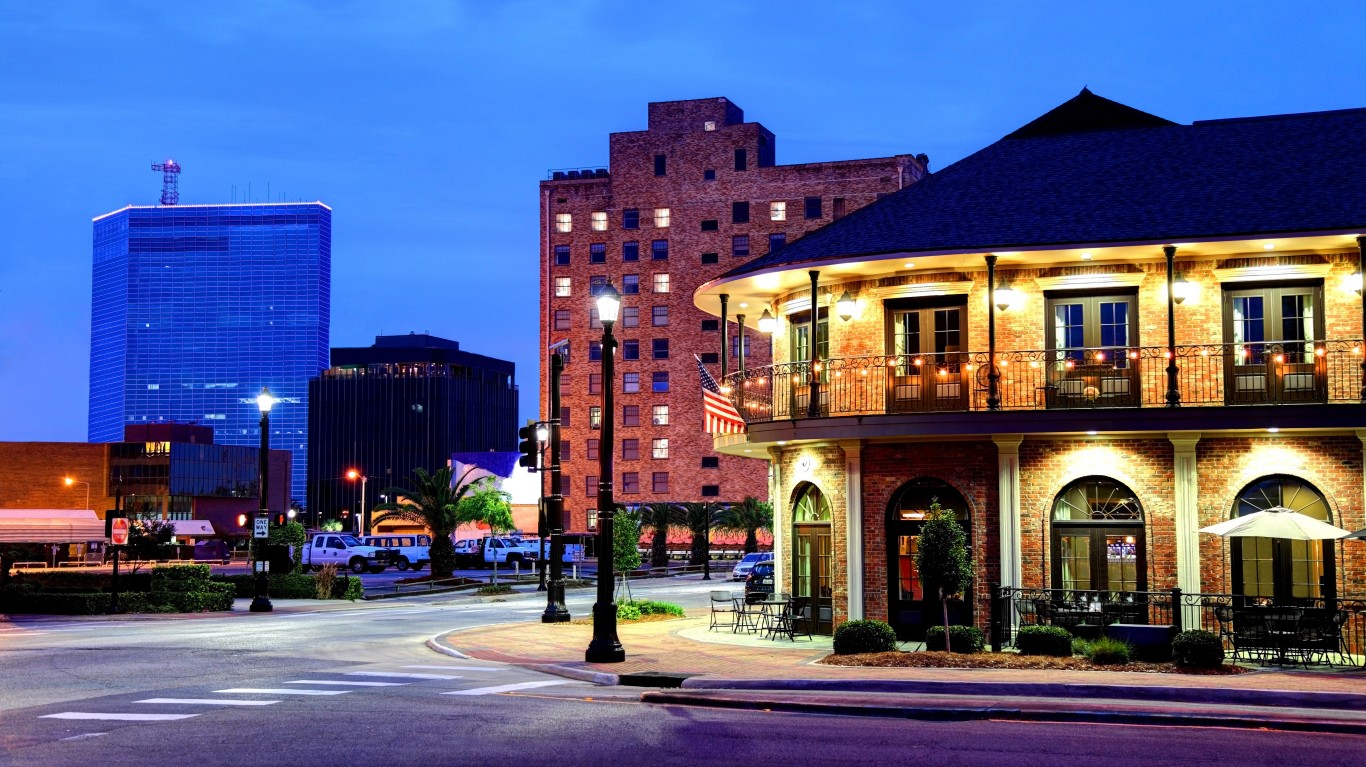
18. Lake Charles, LA
> Sept. 2020 unemployment rate: 11.8%
> 1 yr. employment change: -20.5%
> Largest industry: Mining, logging, and construction (20.4% of local jobs)
> Population: 209,035
Across the United States, the leisure and hospitality industry has been decimated by the COVID-19 pandemic. In Lake Charles, Louisiana, the industry was hit especially hard. Some 6,100 fewer people are working in leisure and hospitality jobs in the metro area today compared to a year ago, a 41.5% decline. For context, the industry shed 21.2% of its workforce nationwide over the same period.
Due to massive job losses in leisure and hospitality and other industries — including trade, transportation, and utilities and mining, logging, and construction — the jobless rate in Lake Charles stands at 11.8%, up from just 4.6% at the beginning of the year.

17. Modesto, CA
> Sept. 2020 unemployment rate: 11.9%
> 1 yr. employment change: -8.8%
> Largest industry: Trade, transportation, and utilities (20.6% of local jobs)
> Population: 550,660
Modesto is one of several cities in California’s Central Valley where at least 10% of the labor force is out of work. Due in large part to the COVID-19 pandemic, over the course of the past year, employment in the trade, transportation, and utilities industry — the largest in the metro area — dropped by 10.3%. Job losses in the area’s leisure and hospitality industry fell by 24.0% over the same period. All told, overall employment fell by 8.8% from September 2019 to September 2020 in Modesto, and the current local unemployment rate of 11.9% is among the highest in the country.
[in-text-ad-2]

16. Fresno, CA
> Sept. 2020 unemployment rate: 12.0%
> 1 yr. employment change: -6.9%
> Largest industry: Education and health services (20.1% of local jobs)
> Population: 999,101
Employment in Fresno, California fell by nearly 7.0% over the past year. As is the case nationwide, the industry reporting the largest one-year drop in employment in Fresno is leisure and hospitality, where the industry now employs about 30% fewer people than last year.
Currently, the monthly unemployment rate in Fresno is 12.0%. Similar to many other cities on this list located in California’s Central Valley, Fresno had a relatively high jobless rate already before the COVID-19 recession. In January 2020, 6.9% of the local labor force was out of work, compared to the 3.6% national unemployment rate.
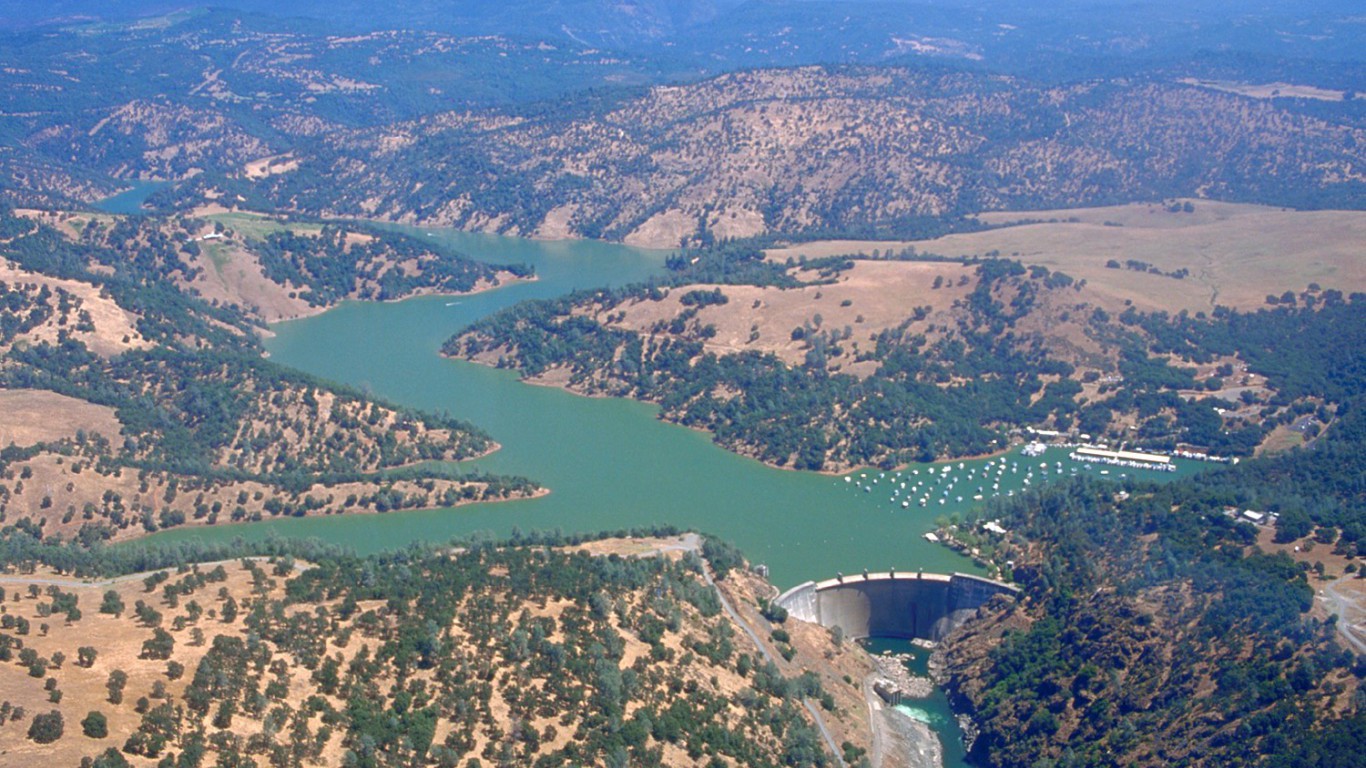
15. Yuba City, CA
> Sept. 2020 unemployment rate: 12.0%
> 1 yr. employment change: -13.4%
> Largest industry: Government (26.5% of local jobs)
> Population: 175,639
Yuba City is one of several California metro areas with a near nation-leading unemployment rate. Due in large part to the COVID-19 recession, there are 6,400 fewer people working in the area now than there were the same time last year, and the local unemployment rate is 12.0% — well above the 7.9% U.S. jobless rate.
The industries that have shed the largest share of their workers in the metro area in the past year are information, leisure and hospitality, and manufacturing.
[in-text-ad]

14. Hanford-Corcoran, CA
> Sept. 2020 unemployment rate: 12.2%
> 1 yr. employment change: -7.5%
> Largest industry: Government (36.3% of local jobs)
> Population: 152,940
The onset of the COVID-19 recession doubled the unemployment rate in California’s Hanford-Corcoran metro area. In February, the jobless rate was 7.7%. By April, 16.6% of the local labor force was out of work.
The current unemployment rate in the metro area of 12.2% is a considerable improvement from six months ago, but it appears to be moving in the wrong direction, as the August rate was nearly a percentage point lower. Nationwide, unemployment has fallen every month since April.

13. Stockton-Lodi, CA
> Sept. 2020 unemployment rate: 12.3%
> 1 yr. employment change: -8.1%
> Largest industry: Trade, transportation, and utilities (28.5% of local jobs)
> Population: 762,148
Between September 2019 and September 2020, the Stockton-Lodi metro area shed about 20,200 jobs. The bulk of those job losses are due to the COVID-19 recession. In February 2020, Stockton-Lodi’s unemployment rate was 5.7%. By April, it soared to 17.7%.
As is the case nationwide, the sector hit hardest by the coronavirus pandemic in Stockton-Lodi was also leisure and hospitality. Over the past year, overall employment fell by 26.1% in the sector — equivalent to nearly 6,000 jobs.

12. Beaumont-Port Arthur, TX
> Sept. 2020 unemployment rate: 12.7%
> 1 yr. employment change: -8.2%
> Largest industry: Trade, transportation, and utilities (19.5% of local jobs)
> Population: 392,563
Beaumont-Port Arthur, Texas, is one of only 16 U.S. metro areas with a September unemployment rate above 12%. Due to steep employment declines in the leisure and hospitality, mining and construction, and professional services sectors, there are about 13,600 fewer people working in the metro area now than there were a year ago.
Though nearly every industry in the metro area shed jobs over the past year, trade, transportation, and utilities — the largest industry in the metro area — actually grew modestly, adding about 100 jobs.
[in-text-ad-2]

11. McAllen-Edinburg-Mission, TX
> Sept. 2020 unemployment rate: 13.0%
> 1 yr. employment change: -5.4%
> Largest industry: Education and health services (29.8% of local jobs)
> Population: 868,707
The McAllen-Edinburg-Mission, Texas, metro area shed a total of 14,500 jobs in the past year, equal to over 5% of its total labor force. Due in large part to job losses in manufacturing, mining and construction and leisure and hospitality, the metro area’s September unemployment rate was 13.0%, well above the 7.9% U.S. rate.
The area is already struggling with high poverty, and the job losses are putting even more residents at risk of serious financial hardship. An estimated 27.3% of McAllen metro area residents live below the poverty line, the highest poverty rate of any metro area in the country and more than double the 12.3% national poverty rate.
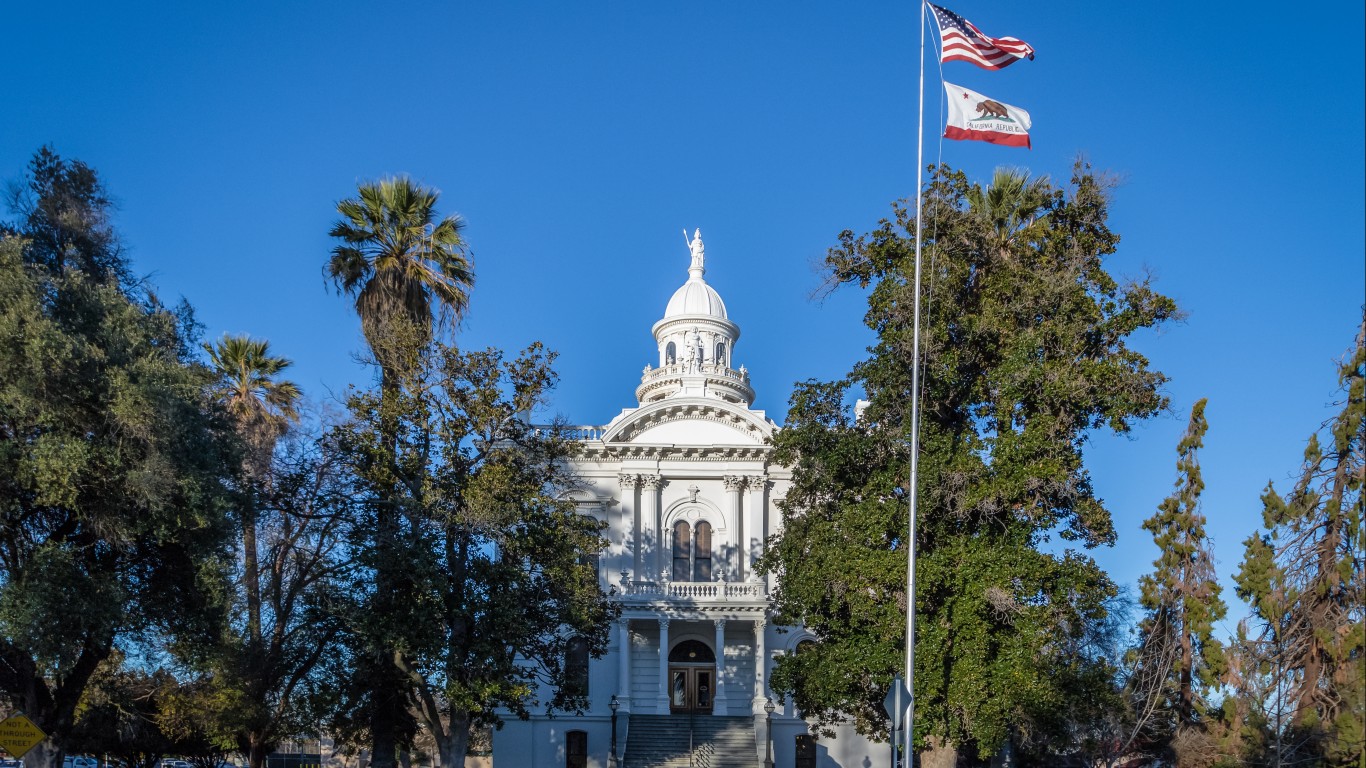
10. Merced, CA
> Sept. 2020 unemployment rate: 13.0%
> 1 yr. employment change: -7.5%
> Largest industry: Government (27.0% of local jobs)
> Population: 277,680
Overall employment has fallen by 7.5% in Merced, California, over the past year. Partially as a result, at 13.0%, the metro area’s unemployment rate is the 10th highest among U.S. metro areas.
Even before the COVID-19 pandemic sent Merced’s jobless rate soaring, unemployment in the metro area was far worse than average. In February 2020, a month before President Donald Trump declared a national emergency in the face of the pandemic, Merced’s unemployment rate was 7.8%, more than double the 3.5% national rate at the time.
[in-text-ad]

9. Odessa, TX
> Sept. 2020 unemployment rate: 13.1%
> 1 yr. employment change: -11.0%
> Largest industry: Mining, logging, and construction (26.0% of local jobs)
> Population: 166,223
Of the five metro areas in Texas with double digit unemployment rates, Odessa has the highest rate. As of September, 13.1% of the local labor force was out of work, well above the 7.9% U.S. unemployment rate. While the jobless rate has been improving steadily nationwide, in Odessa it is getting worse. Though the current 13.1% monthly unemployment rate is well below the recent 16.5% high reported in May, it is greater than the 10.7% jobless rate in August.
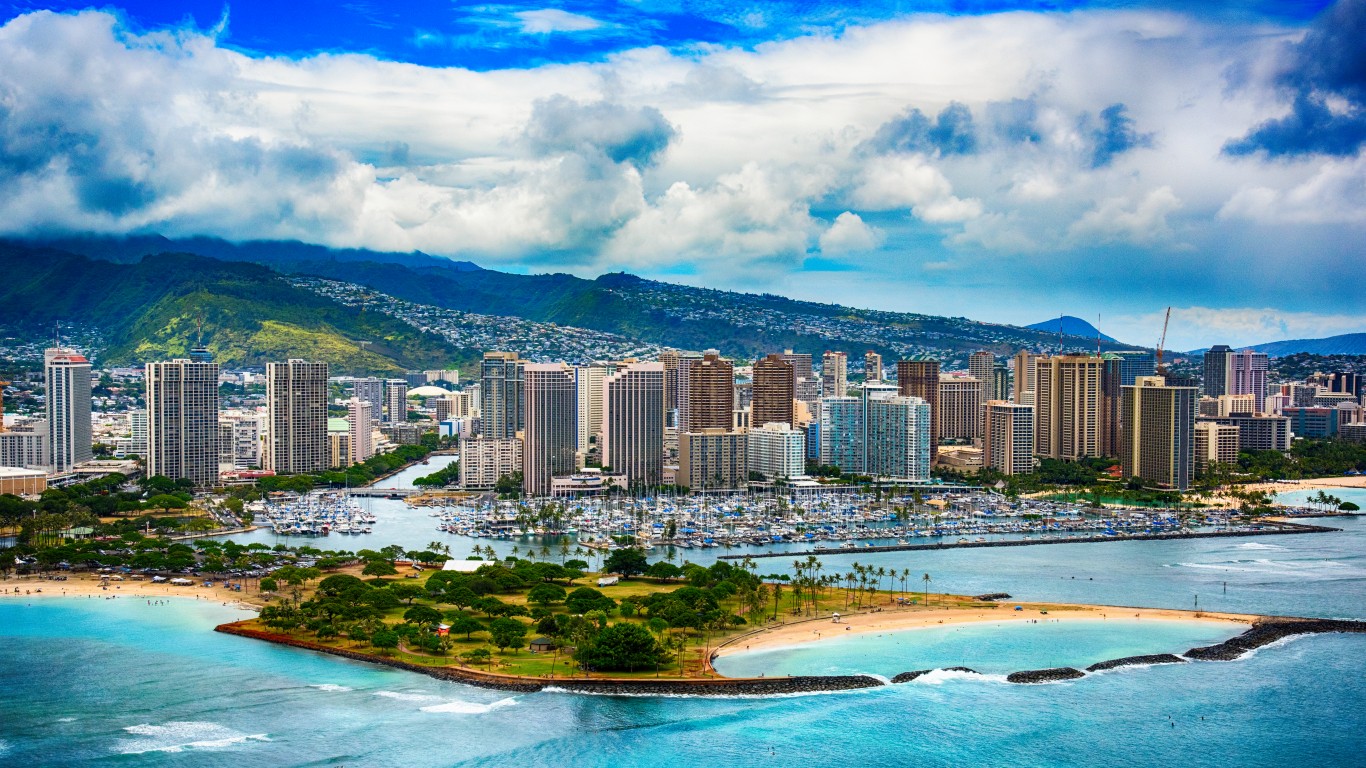
8. Urban Honolulu, HI
> Sept. 2020 unemployment rate: 13.3%
> 1 yr. employment change: -17.0%
> Largest industry: Government (20.6% of local jobs)
> Population: 974,563
Few state economies depend on tourism as much as Hawaii’s — and the coronavirus pandemic has been devastating to the state. So far this year, the state has reported only 2.2 million visitors, down 72% from the 7.7 million visitors at the same time last year.
In Honolulu, about 80,000 fewer people are now working than a year ago — and over half of the lost jobs were in the leisure and hospitality sector. The metro area’s unemployment rate of 13.3% is well above the comparable 7.9% national jobless rate.

7. Los Angeles-Long Beach-Anaheim, CA
> Sept. 2020 unemployment rate: 13.4%
> 1 yr. employment change: -9.3%
> Largest industry: Trade, transportation, and utilities (17.7% of local jobs)
> Population: 13.2 million
The Los Angeles metro area is one of the largest in the nation, with over 13.2 million residents. L.A.is also struggling with one of the worst unemployment crises in the country, as 13.4% of the local labor force is now unemployed. The area’s leisure and hospitality industry alone shed more than 230,000 jobs in the past year.
And unemployment in California is likely not to improve soon, as cases of the virus have surged in recent weeks and relatively strict lockdown measures are being enforced in much of the state.
[in-text-ad-2]
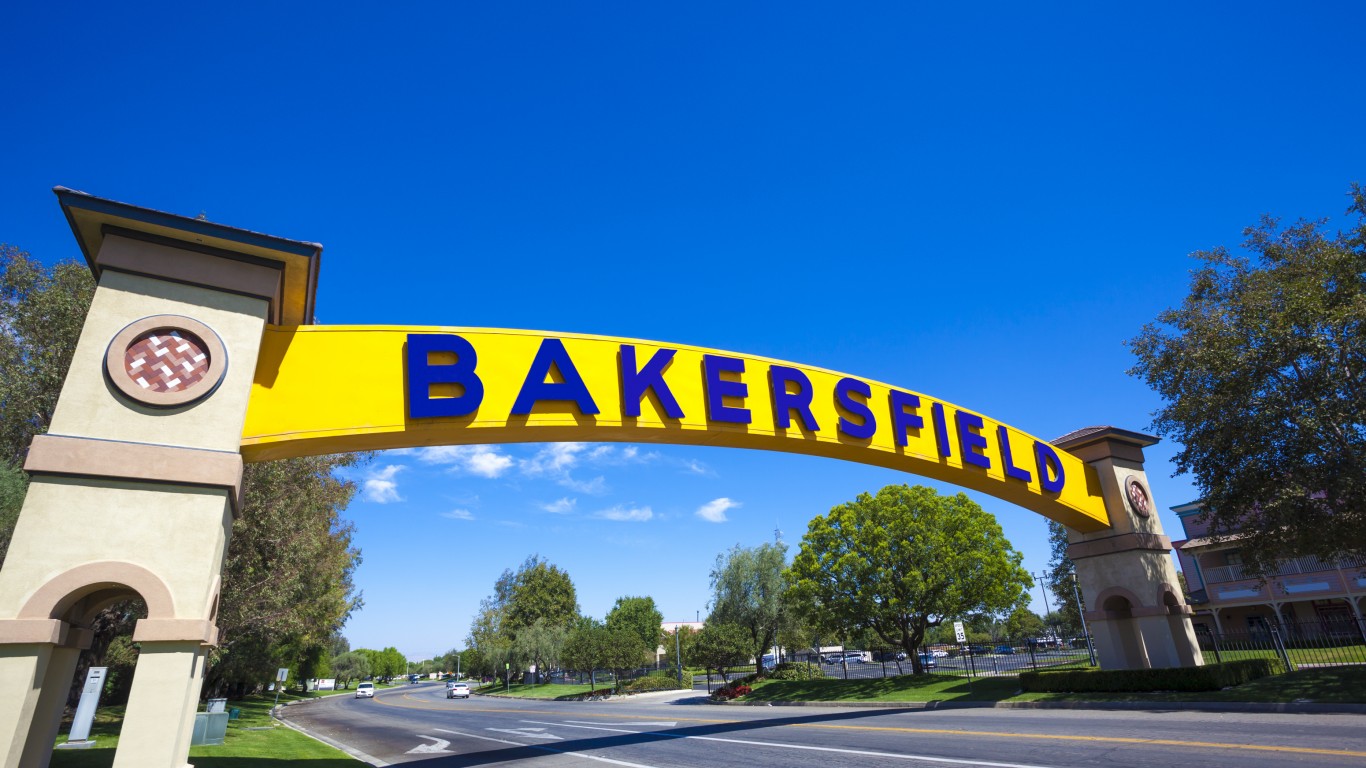
6. Bakersfield, CA
> Sept. 2020 unemployment rate: 13.7%
> 1 yr. employment change: -9.0%
> Largest industry: Government (24.6% of local jobs)
> Population: 900,202
Bakersfield is one of 12 metro areas in California to rank on this list. As is the case nationwide, workers in Bakersfield’s leisure and hospitality industry were the most likely to lose their job over the past year. Since September 2019, as the COVID-19 pandemic effectively ground nonessential travel to a halt for several months, the number of people working in leisure and hospitality in the area fell by 26.6%.

5. Visalia-Porterville, CA
> Sept. 2020 unemployment rate: 13.9%
> 1 yr. employment change: -5.7%
> Largest industry: Government (25.9% of local jobs)
> Population: 466,195
Nearly 14% of the labor force in California’s Visalia-Porterville metro area are currently out of work. Over the last 12 months, the area has shed some 7,400 jobs. The largest declines in employment were in the services industry, which shed about one in every five jobs, and in education and health care, which reported a 17.1% overall decline in employment from September 2019 to September 2020.
[in-text-ad]

4. Yuma, AZ
> Sept. 2020 unemployment rate: 14.7%
> 1 yr. employment change: -4.1%
> Largest industry: Government (26.4% of local jobs)
> Population: 213,787
Yuma is the only metro area in Arizona with a double digit unemployment rate, and one of only four cities nationwide where the unemployment rate is above 14%. Unlike nearly every other metro area on this list, it is not clear that Yuma’s near nation-leading jobless rate is a direct result of the COVID-19 recession.
Unemployment is typically far higher in Yuma than it is in nearly every other corner of the country. In fact, Yuma is the only metro area in the country where unemployment was higher one year ago than it is today. In September 2019, the metro area’s unemployment rate was 16.5%, 1.8 percentage points higher than it is now.
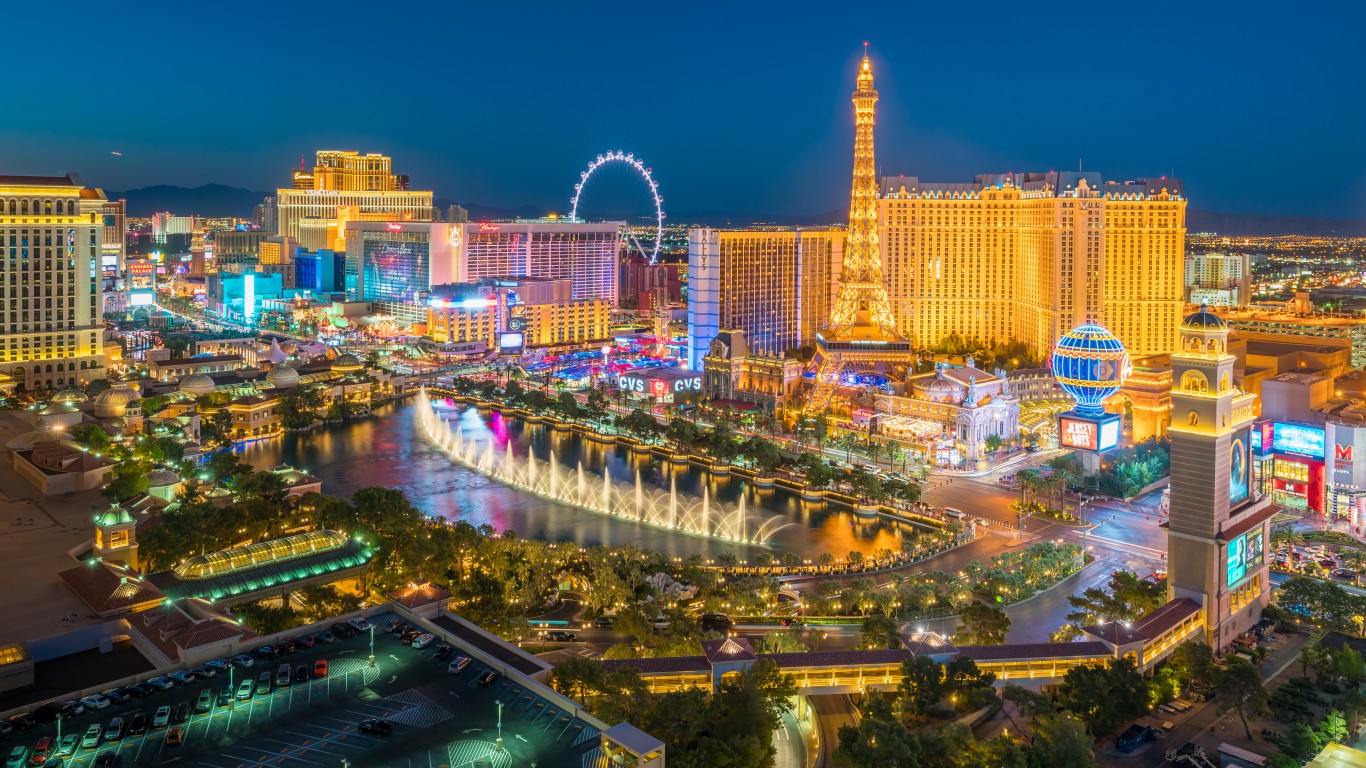
3. Las Vegas-Henderson-Paradise, NV
> Sept. 2020 unemployment rate: 14.8%
> 1 yr. employment change: -11.3%
> Largest industry: Leisure and hospitality (28.2% of local jobs)
> Population: 2.3 million
Unemployment in the Las Vegas metro area stands at 14.8% — the third highest jobless rate of any U.S. metro area. The metro area’s unemployment crisis was ushered in by the COVID-19 pandemic, as the industry hit hardest during the ensuing recession is also Las Vegas’s largest industry by employment: leisure and hospitality.
A popular tourist destination, Las Vegas’s leisure and hospitality industry employs over a quarter of the labor force — and there are about 67,400 fewer people working in those jobs than there were a year ago. So far this year, Las Vegas has reported fewer than 15 million visitors, down from nearly 32 million at the same point in 2019.
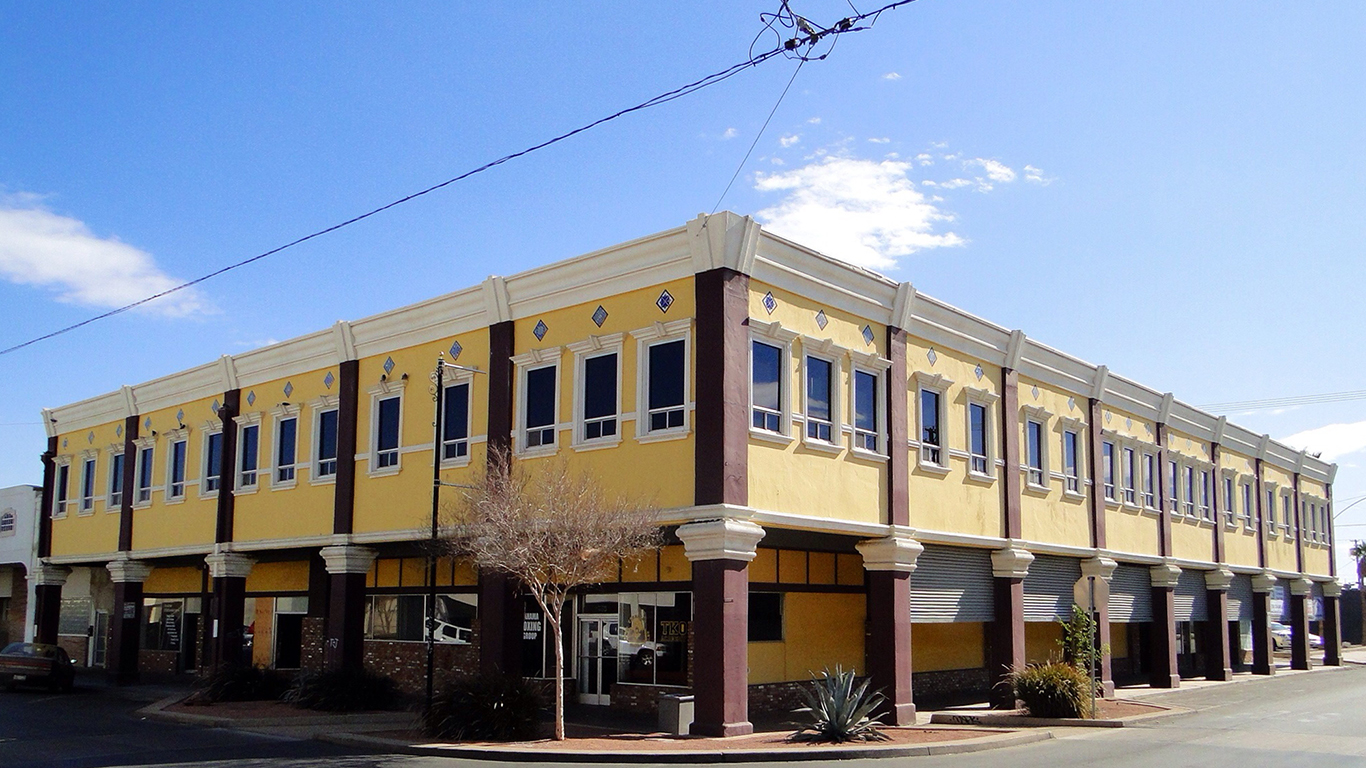
2. El Centro, CA
> Sept. 2020 unemployment rate: 20.5%
> 1 yr. employment change: -7.0%
> Largest industry: Government (36.0% of local jobs)
> Population: 181,215
El Centro’s unemployment rate of 20.5% is the second highest of any U.S. metro area. In April, the national unemployment rate peaked at 14.7% as large segments of the economy shut down in an attempt to slow the virus’s spread. That month, the jobless rate hit 30% in El Centro.
While El Centro’s economy was not spared by the COVID-19 pandemic, unemployment in the area was high long before 2020. The current jobless rate in the metro area is only slightly higher than it was in September 2019, when it stood at 18.3%.
[in-text-ad-2]
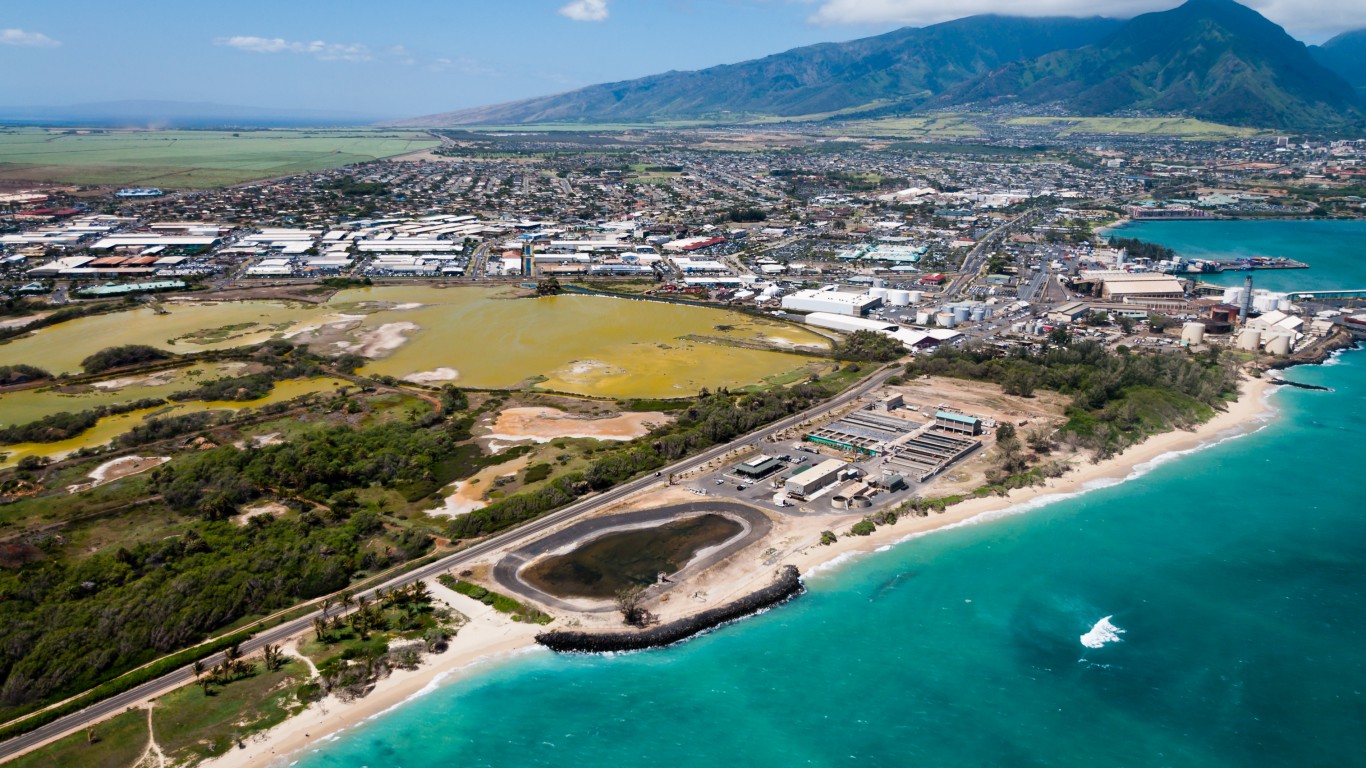
1. Kahului-Wailuku-Lahaina, HI
> Sept. 2020 unemployment rate: 23.3%
> 1 yr. employment change: -29.6%
> Largest industry: Leisure and hospitality (31.8% of local jobs)
> Population: 167,488
The leisure and hospitality industry is the backbone of the Kahului-Wailuku-Lahaina metro area’s economy — and it has been decimated by the COVID-19 pandemic. As efforts to contain the spread of the virus ground nonessential travel to a halt for months, tourism in Hawaii plunged by 72% in 2020 compared to the same period last year. In Kahului-Wailuku-Lahaina, this has resulted in a nearly 69% drop in employment in the leisure and hospitality industry.
All together, there are 23,600 fewer jobs in the metro area than there were at the same time last year — and the monthly unemployment rate is a nation leading 23.3%.
Methodology
To determine the cities with double-digit unemployment, 24/7 Wall St. reviewed seasonally adjusted unemployment rates at the metropolitan area level for September 2020 from the Local Area Unemployment Statistics program of the Bureau of Labor Statistics. We identified the 46 cities where at least 10% of the workforce is unemployed. In the case of a tie, the metro area where overall employment fell the most in the last year was ranked higher.
Data on historical monthly unemployment also came from the BLS. Supplemental data on employment by industry came from the Bureau of Labor Statistics’ Current Employment Statistics program and are not seasonally adjusted.
Additional data on median household income and poverty came from the U.S. Census Bureau’s American Community Survey and are one-year estimates for 2019.
Thank you for reading! Have some feedback for us?
Contact the 24/7 Wall St. editorial team.